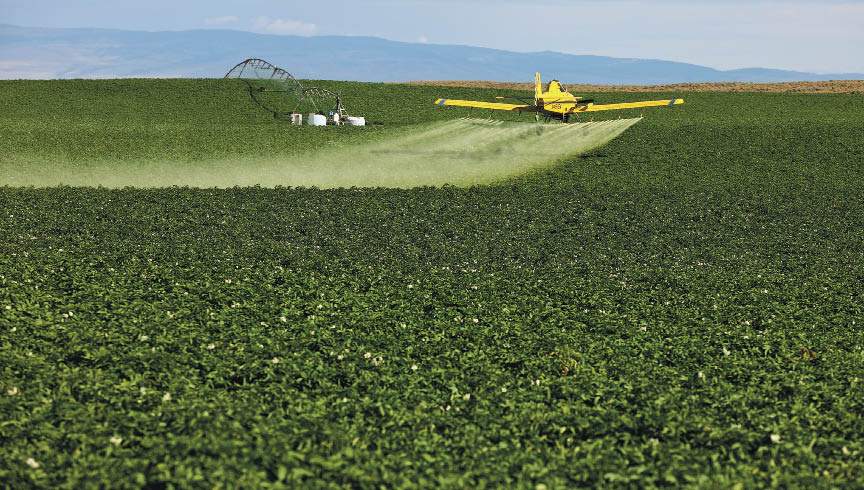 In answer to a 2009 Federal Court ruling, the U.S. EPA has developed a Clean Water Act (CWA) discharge permit covering pesticide applications to waters of the United States. This article is a quick review of where we are, where we're going in the near future and what agricultural growers need to know about this new permit.
In answer to a 2009 Federal Court ruling, the U.S. EPA has developed a Clean Water Act (CWA) discharge permit covering pesticide applications to waters of the United States. This article is a quick review of where we are, where we're going in the near future and what agricultural growers need to know about this new permit.
First, the 2009 court decision did not affect the existing CWA permitting exemptions for agricultural runoff and irrigation return flow from agricultural fields, both of which may contain pesticides but do not require CWA permits. Also, pesticide applications to land that do not result in a discharge of pesticides to waters of the U.S. (example: controlling pests on agricultural crops, forest floors or range lands) do not require CWA pesticide permits.
Since most growers do not apply pesticides in or over waters of the U.S., they would not need to obtain a CWA pesticide permit. Therefore, most growers are not affected by the Court's decision and do not need CWA permits for their pesticide applications.
So, under what circumstances would agricultural growers need a CWA pesticide permit? If growers apply pesticides in or over waters of the U.S. or if they allow their application equipment (such as center pivot irrigation systems or end-guns) to spray pesticides in or over waters of the U.S., they would need to obtain a CWA pesticide permit for those applications. Any pesticide application made into waters of the U.S., e.g. the dry area of land extending from the ordinary high water mark down to and including the actual water would need a CWA permit.
In most of the U.S., state-led programs enforce the Clean Water Act. In potato-growing states including Washington, Wisconsin, North Dakota, Colorado, Minnesota, Oregon, California and Michigan, each of those states issue and enforce their own water pollution discharge permits. Anyone needing a pesticide general permit would obtain it from their state's permitting office.
EPA's PGP will cover pesticide applications in the areas where EPA is the permitting authority, including Idaho, Massachusetts, New Hampshire, New Mexico, Oklahoma, Alaska, the District of Columbia, most U.S. territories and Indian country lands, and many federal facilities. Anyone needing the pesticide general permit in those areas would obtain it from the EPA.
The genesis of the current permit dates to a 2006 EPA Aquatic Pesticides rule, which stated that CWA discharge permits were not required for pesticides applied to water to control pests and vegetation, so long as the applicator followed the pesticide's label restrictions and instructions. The label, in effect, was the permit.
In 2007, industry and environmental groups mounted a legal challenge to the rule, with the U.S. Sixth Circuit Court of Appeals deciding in 2009 that the EPA rule and regulatory approach did not square with the Clean Water Act. Based on that Court decision, the existing Aquatic Pesticide rule was revoked, and water pollution discharge permits are now required for "all pesticide applications in, over or near waters of the U.S."
Following the ruling, industry groups began a series of legal appeals, and in 2010 the Supreme Court declined their request to review the Sixth Circuit's decision. EPA began developing a pesticide general permit that became effective in areas of the country for which EPA is the NPDES permitting authority, on October 31, 2011.
Shortly after the 2009 Court ruling, EPA embarked on an extensive outreach effort across Pacific Northwest potato-growing states, meeting with the public and pesticide applicators, to understand their concerns and listen to suggested improvements. In all, EPA has attended more than 70 meetings in Idaho, Oregon, Washington and Colorado with 4,300 pesticide applicators, individuals and agricultural producers.
Using a combination of public meetings, websites and email lists, those interested were kept in close contact with each step of the permit process. In the summer of 2010, EPA launched a public comment period on the proposed permit and received 771 sets of written comments. Those comments and other information received at the public meetings helped make the final permit less burdensome, easier to implement yet still protective for our rivers and streams.
The CWA pesticide general permit will require applicators to consider alternatives to pesticide applications and ensure applicators use the correct pesticide and the minimum effective application rate. Applicators are required to perform annual maintenance and calibrate their equipment to ensure applications are made at the correct application rate. Some larger entities may have additional recordkeeping and reporting requirements.
Today, EPA's pesticide general permit stands as an example of how the best science, combined with robust public involvement and a common-sense approach to permit writing can create a strong, fair permit that minimizes impacts on the pesticide applicator.
For more information about obtaining the pesticide general permit in Idaho or for further information, call Dirk Helder, U.S. EPA in Boise at (208) 378-5749.